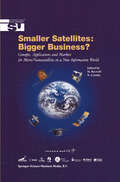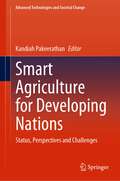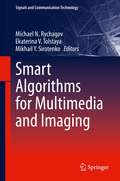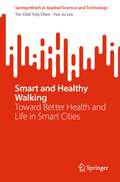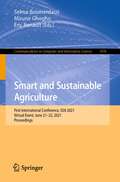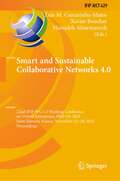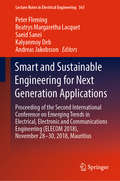- Table View
- List View
Small Teaching Online: Applying Learning Science in Online Classes
by Flower Darby James M. LangFind out how to apply learning science in online classes The concept of small teaching is simple: small and strategic changes have enormous power to improve student learning. Instructors face unique and specific challenges when teaching an online course. This book offers small teaching strategies that will positively impact the online classroom. This book outlines practical and feasible applications of theoretical principles to help your online students learn. It includes current best practices around educational technologies, strategies to build community and collaboration, and minor changes you can make in your online teaching practice, small but impactful adjustments that result in significant learning gains. • Explains how you can support your online students • Helps your students find success in this non-traditional learning environment • Covers online and blended learning • Addresses specific challenges that online instructors face in higher education Small Teaching Online presents research-based teaching techniques from an online instructional design expert and the bestselling author of Small Teaching.
Smaller Satellites: Concepts, Applications and Markets for Micro/Nanosatellites in a New Information World (Space Studies #6)
by M. RycroftY. Fujimori, Symposium Programme Committee Chair, and Faculty Member, International Space University e-mail: fujimori@isu.isunet.edu M.Rycroft, Faculty Member, International Space University e-mail: rycroft@isu.isunet.edu N. Crosby, International Space University e-mail: norma@bock-crosby.fsbusines.co.uk For the sixth annual ISU Symposium the theme was "Smaller Satellites: Bigger Business? Concepts, Applications and Markets for Micro/Nanosatellites in a New Information World". Thus, the Symposium addressed the crucial question: are small satellites the saviour of space programmes around the world It did this from the unique perspective of the International Space today? University - the interdisciplinary, international and intercultural perspective. This Symposium brought together a variety of people working on small satellites - engineers, scientists, planners, providers, operators, policy makers and business executives, together with representatives from regulatory bodies, from national and international organizations, and from the finance sector, and also entrepreneurs. Discussion and debate were encouraged, based on the papers presented and those published here.
Smalltalk and Object Orientation: An Introduction
by John HuntThis book was originally written to support an introductory course in Object Orientation through the medium of Smalltalk (and VisualWorks in particular). However, it can be used as a book to teach the reader Smalltalk, to introduce object orientation as well as present object oriented design and analysis. It takes as its basic premise that most Computer Scientists I Software Engineers learn best by doing rather than from theoretical notes. The chapters therefore attempt to introduce concepts by getting you the reader to do things, rather than by extensive theoretical discussions. This means that these chapters take a hands-on approach to the subject and assume that the student/reader has a suitable Small talk environment available to them. The chapters are listed below and are divided into six parts. The reader is advised to work through Parts 1 and 3 thoroughly in order to gain a detailed understanding of object orientation. Part 2 then provides an introduction to the Smalltalk environment and language. Other chapters may then be dipped into as required. For example, if the reader wishes to hone their Smalltalk skills then the chapters in Part 4 would be useful. However, if at that point they wish to get on and discover the delights of graphical user interfaces in Smalltalk, then Part 5 could be read next. Part 6 presents some more advances subjects such as metaclasses and concurrency which are not required for straight forward Small talk development.
Smarketing: How to Achieve Competitive Advantage through Blended Sales and Marketing
by Tim Hughes Adam Gray Hugo WhicherSince the earliest days of 'modern' marketing and sales, the departments that ran these key functions have been separate empires. They have different leaders, different budgets, and different organizational structures. However, with the overwhelming impact of continuous disruption, many organizations have been left floundering, unsure of how to get traction in the market. The old rule book has been torn up and thrown away.Smarketing is the first book that explores the shift that will become the future state operating model for companies seeking to remain competitive and relevant in this fast-changing digital world. It explains how and why companies should blend sales and marketing into one single, streamlined smarketing department. Sales people will become better marketers, and marketers better sales people, leading to bigger, better business growth all round.With clearly defined implementation strategies that can be applied by any company, regardless of size or sector, Smarketing is an invaluable resource for any marketing or sales professional looking to drive growth and success in the new era of marketing.
Smarketing: How to Achieve Competitive Advantage through Blended Sales and Marketing
by Tim Hughes Adam Gray Hugo WhicherSince the earliest days of 'modern' marketing and sales, the departments that ran these key functions have been separate empires. They have different leaders, different budgets, and different organizational structures. However, with the overwhelming impact of continuous disruption, many organizations have been left floundering, unsure of how to get traction in the market. The old rule book has been torn up and thrown away.Smarketing is the first book that explores the shift that will become the future state operating model for companies seeking to remain competitive and relevant in this fast-changing digital world. It explains how and why companies should blend sales and marketing into one single, streamlined smarketing department. Sales people will become better marketers, and marketers better sales people, leading to bigger, better business growth all round.With clearly defined implementation strategies that can be applied by any company, regardless of size or sector, Smarketing is an invaluable resource for any marketing or sales professional looking to drive growth and success in the new era of marketing.
Smart Agents for the Industry 4.0: Enabling Machine Learning in Industrial Production
by Max HoffmannMax Hoffmann describes the realization of a framework that enables autonomous decision-making in industrial manufacturing processes by means of multi-agent systems and the OPC UA meta-modeling standard. The integration of communication patterns and SOA with grown manufacturing systems enables an upgrade of legacy environments in terms of Industry 4.0 related technologies. The added value of the derived solutions are validated through an industrial use case and verified by the development of a demonstrator that includes elements of self-optimization through Machine Learning and communication with high-level planning systems such as ERP.About the Author: Dr.-Ing. Max Hoffmann is a scientific researcher at the Institute of Information Management in Mechanical Engineering, RWTH Aachen University, Germany, and leads the group “Industrial Big Data”. His research emphasizes on production optimization by means of data integration through interoperability and communication standards for industrial manufacturing and integrated analysis by using Machine Learning and stream-based information processing.
Smart Agriculture Automation Using Advanced Technologies: Data Analytics and Machine Learning, Cloud Architecture, Automation and IoT (Transactions on Computer Systems and Networks)
by Amitava Choudhury Arindam Biswas T. P. Singh Santanu Kumar GhoshThis book addresses the challenges for developing and emerging trends in Internet-of-Things (IoT) for smart agriculture platforms. It also describes data analytics & machine learning, cloud architecture, automation & robotics and aims to overcome existing barriers for smart agriculture with commercial viability. It discusses IoT-based monitoring systems for analyzing the crop environment, and methods for improving the efficiency of decision-making based on the analysis of harvest statistics. The book explores a range of applications including intelligent field monitoring, intelligent data processing and sensor technologies, predictive analysis systems, crop monitoring, and weather data-enabled analysis in IoT agro-systems. This volume will be helpful for engineering and technology experts and researchers, as well as for policy-makers.
Smart Agriculture for Developing Nations: Status, Perspectives and Challenges (Advanced Technologies and Societal Change)
by Kandiah PakeerathanThis book in its eighteen chapters provides sustainable and smart technology-based solutions to developing nations. Smart farming is growing in importance due to the increasing demand for higher crop yield, the need for using natural resources efficiently, the rising use and sophistication of information and communication technology and the increasing need for climate-smart agriculture. Some of these chapters deal with the applications of smart agriculture to address the special challenges of the Small Island Developing States for sustainable agriculture. The book brings together scientific communities from India, Indonesia, Iraq, Malaysia, Mauritius, Myanmar, Palestine, Sri Lanka and South Africa to share their expertise to make the farming system more connected and intelligent. The smart farming techniques shared in different chapters not only help to reduce the overall cost and improve the quality and quantity of products but altogether help improve the sustainability of agriculture in the developing world.‘Smart Farming’ is a management concept focused on providing the agricultural industry with the infrastructure to leverage advanced technologies—including artificial intelligence (AI), big data, robotics, drones and Internet of Things (IoT)—for tracking, monitoring, automating and analyzing operations. Sometimes known as precision agriculture, smart farming is software managed and sensor monitored.
Smart Agritech: Robotics, AI, and Internet of Things (IoT) in Agriculture
by Korhan Cengiz Durgesh Srivastava Santosh Kumar Srivastava Pramod GaurThe main goal of Smart Agritech: Robotics, AI, and Internet of Things (IoT) in Agriculture is to explore how emerging technologies such as robotics, artificial intelligence (AI), and IoT can be leveraged to improve efficiency, sustainability, and productivity in agriculture. Agriculture has always been a vital sector of the global economy, providing food and raw materials for industries and households. However, with the growing population, changing climate conditions, and limited resources, the agriculture sector faces numerous challenges. To address these challenges, farmers and agricultural companies are turning to advanced technologies such as Robotics, Artificial Intelligence (AI), and the Internet of Things (IoT). This exciting new volume provides a comprehensive overview of the latest technological advances in agriculture, focusing on these three cutting-edge technologies. The book will explore the potential benefits of these technologies in improving agricultural efficiency, productivity, and sustainability. Whether for the veteran engineer, scientist in the lab, student, or faculty, this groundbreaking new volume is a valuable resource for researchers and other industry professionals interested in the intersection of technology and agriculture.
Smart Agritech: Robotics, AI, and Internet of Things (IoT) in Agriculture
by Korhan Cengiz Durgesh Srivastava Santosh Kumar Srivastava Pramod GaurThe main goal of Smart Agritech: Robotics, AI, and Internet of Things (IoT) in Agriculture is to explore how emerging technologies such as robotics, artificial intelligence (AI), and IoT can be leveraged to improve efficiency, sustainability, and productivity in agriculture. Agriculture has always been a vital sector of the global economy, providing food and raw materials for industries and households. However, with the growing population, changing climate conditions, and limited resources, the agriculture sector faces numerous challenges. To address these challenges, farmers and agricultural companies are turning to advanced technologies such as Robotics, Artificial Intelligence (AI), and the Internet of Things (IoT). This exciting new volume provides a comprehensive overview of the latest technological advances in agriculture, focusing on these three cutting-edge technologies. The book will explore the potential benefits of these technologies in improving agricultural efficiency, productivity, and sustainability. Whether for the veteran engineer, scientist in the lab, student, or faculty, this groundbreaking new volume is a valuable resource for researchers and other industry professionals interested in the intersection of technology and agriculture.
Smart Algorithms for Multimedia and Imaging (Signals and Communication Technology)
by Michael N. Rychagov Ekaterina V. Tolstaya Mikhail Y. SirotenkoThis book presents prospective, industrially proven methods and software solutions for storing, processing, and viewing multimedia content on digital cameras, camcorders, TV, and mobile devices. Most of the algorithms described here are implemented as systems on chip firmware or as software products and have low computational complexity and memory consumption. In the four parts of the book, which contains a total of 16 chapters, the authors address solutions for the conversion of images and videos by super-resolution, depth estimation and control and mono-to-stereo (2D to 3D) conversion; display applications by video editing; the real-time detection of sport episodes; and the generation and reproduction of natural effects. The practical principles of machine learning are illustrated using technologies such as image classification as a service, mobile user profiling, and automatic view planning with dictionary-based compressed sensing in magnetic resonance imaging. The implementation of these technologies in mobile devices is discussed in relation to algorithms using a depth camera based on a colour-coded aperture, the animated graphical abstract of an image, a motion photo, and approaches and methods for iris recognition on mobile platforms. The book reflects the authors’ practical experience in the development of algorithms for industrial R&D and the commercialization of technologies.Explains digital techniques for digital cameras, camcorders, TV, mobile devices;Offers essential algorithms for the processing pipeline in multimedia devices and accompanying software tools;Features advanced topics on data processing, addressing current technology challenges.
Smart and Digital Cities: From Computational Intelligence to Applied Social Sciences (Urban Computing)
by Vitor Nazário Coelho Igor Machado Coelho Thays A. Oliveira Luiz Satoru OchiThis book presents up-to-date information on the future digital and smart cities. In particular, it describes novel insights about the use of computational intelligence techniques and decentralized technologies, covering urban aspects and services, cities governance and social sciences. The topics covered here range from state-of-the-art computational techniques to current discussions regarding drones, blockchain, smart contracts and cryptocurrencies.The idealization of this material emerged with a journey of free knowledge exchange from a diverse group of authors, who met each other through four different events (workshops and special sessions) organized with the purpose of boosting the concepts surrounding smart cities.We believe that this book comprises innovative and precise information regarding state-of-the-art applications and ideas for the future of cities and society. It will surely be useful not only for the academic community but also to the industry professionals and city managers.
Smart and Gets Things Done: Joel Spolsky's Concise Guide to Finding the Best Technical Talent
by Avram Joel SpolskyA "good" programmer can outproduce five, ten, and sometimes more run-of-the-mill programmers. The secret to success for any software company then is to hire the good programmers. But how to do that? In Joel on Hiring, Joel Spolsky draws from his experience both at Microsoft and running his own successful software company based in New York City. He writes humorously, but seriously about his methods for sorting resumes, for finding great candidates, and for interviewing, in person and by phone. Joel’s methods are not complex, but they do get to the heart of the matter: how to recognize a great developer when you see one.
Smart and Healthy Walking: Toward Better Health and Life in Smart Cities (SpringerBriefs in Applied Sciences and Technology)
by Tin-Chih Toly Chen Yun-Ju LeeThis book examines smart technologies and their invaluable role in augmenting the walking experience of mobile users. From meticulously planned walking routes to precise footprint detection and analysis, as well as cutting-edge fall detection and prevention mechanisms, these intelligent technologies have the potential to revolutionize healthy and smart walking. Against the backdrop of the post-COVID-19 era, where unrestricted mobility has become pivotal for restoring normalcy, the demand for smart healthcare solutions has soared. The book explores latest advances in sensor technology, cloud computing, deep learning, and networking and related innovative applications that can leverage smart technologies to enhance healthy walking.
Smart and Innovative Trends in Next Generation Computing Technologies: Third International Conference, NGCT 2017, Dehradun, India, October 30-31, 2017, Revised Selected Papers, Part I (Communications in Computer and Information Science #827)
by Pushpak Bhattacharyya Hanumat G. Sastry Venkatadri Marriboyina Rashmi SharmaThe two-volume set CCIS 827 and 828 constitutes the thoroughly refereed proceedings of the Third International Conference on Next Generation Computing Technologies, NGCT 2017, held in Dehradun, India, in October 2017. The 135 full papers presented were carefully reviewed and selected from 948 submissions. There were organized in topical sections named: Smart and Innovative Trends in Communication Protocols and Standards; Smart and Innovative Trends in Computational Intelligence and Data Science; Smart and Innovative Trends in Image Processing and Machine Vision; Smart Innovative Trends in Natural Language Processing for Indian Languages; Smart Innovative Trends in Security and Privacy.
Smart and Innovative Trends in Next Generation Computing Technologies: Third International Conference, NGCT 2017, Dehradun, India, October 30-31, 2017, Revised Selected Papers, Part II (Communications in Computer and Information Science #828)
by Pushpak Bhattacharyya Hanumat G. Sastry Venkatadri Marriboyina Rashmi SharmaThe two-volume set CCIS 827 and 828 constitutes the thoroughly refereed proceedings of the Third International Conference on Next Generation Computing Technologies, NGCT 2017, held in Dehradun, India, in October 2017. The 135 full papers presented were carefully reviewed and selected from 948 submissions. There were organized in topical sections named: Smart and Innovative Trends in Communication Protocols and Standards; Smart and Innovative Trends in Computational Intelligence and Data Science; Smart and Innovative Trends in Image Processing and Machine Vision; Smart Innovative Trends in Natural Language Processing for Indian Languages; Smart Innovative Trends in Security and Privacy.
Smart and Intelligent Systems: Proceedings of SIS 2021 (Algorithms for Intelligent Systems)
by Subhojit Dawn Kedar Nath Das Rammohan Mallipeddi Debi Prasanna AcharjyaThis book is a collection of high-quality research papers presented at the International Conference on Smart and Intelligent Systems (SIS 2021), which will be held in Velagapudi Ramakrishna Siddhartha Engineering College (VRSEC), Andhra Pradesh, India, during February 25–26, 2021, in virtual mode. It highlights how recent informatics intelligent systems have successfully been used to develop innovative smart techniques and infrastructure in the field of modern engineering and technology. The book will also be of interest to those working in the field of computational intelligence, smart computer network and security analysis, control and automation system, cloud computing, fog computing and IoT, smart grid communication, smart cities, solar cell synthesis and their performance, green technology, and many more. The contents of this book prove useful to researchers and professionals.
Smart and Intelligent Systems: The Human Elements in Artificial Intelligence, Robotics, and Cybersecurity (The Human Element in Smart and Intelligent Systems)
by Abbas Moallem"The more we know about smart and intelligent systems and their use, the more productive organizations can become, and the more quality of life will improve."—Gavriel Salvendy, President Academy of Science, Engineering and Medicine of Florida, University Distinguished Professor University of Central Florida" "Robots, drones, self-driving cars, and personal assistants are only some of the ‘intelligent’ and ‘smart’ systems which are populating our world and changing the way we use technology to carry out our everyday activities, bringing about both exciting opportunities for human-technology symbiosis, as well as compelling design and development challenges. Through a carefully selected choice of chapters, authored by top scientists in the field, this book, edited by Abbas Moallem, sheds light on fundamental aspects of intelligent and smart systems, investigating the role and impact of affective and psychophysiological computing, machine learning, cybersecurity, agent transparency, and human-agent teaming in the shaping of this new interaction paradigm, as well as the human factors involved in their application in critical domains such as health, education, and manufacturing in the emerging technological landscape."—Constantine Stephanidis, Professor of Computer Science, University of Crete, Distinguished member of Foundation for Research and Technology - Hellas (FORTH) In today’s digital world, the words "smart" and intelligent" are now used to label devices, machinery, systems, and even environments. What is a "smart" system? Is "smart" synonymous with "intelligent"? If not, what does an "intelligent system" mean? Are all smart systems intelligent? This book tries to answer these questions by summarizing the existing research in various areas and providing new research findings. Smart and Intelligent Systems: The Human Elements in Artificial Intelligence, Robotics, and Cybersecurity presents new areas of smart and intelligent system design. It defines smart and intelligent systems, offers a human factors approach, discusses networking applications, and combines the human element with smart and intelligent systems. This book is perfect for engineering students in data sciences and artificial intelligence and practitioners at all levels in the fields of human factors and ergonomics, systems engineering, computer science, software engineering, and robotics.
Smart and Intelligent Systems: The Human Elements in Artificial Intelligence, Robotics, and Cybersecurity (The Human Element in Smart and Intelligent Systems)
by Abbas Moallem"The more we know about smart and intelligent systems and their use, the more productive organizations can become, and the more quality of life will improve."—Gavriel Salvendy, President Academy of Science, Engineering and Medicine of Florida, University Distinguished Professor University of Central Florida" "Robots, drones, self-driving cars, and personal assistants are only some of the ‘intelligent’ and ‘smart’ systems which are populating our world and changing the way we use technology to carry out our everyday activities, bringing about both exciting opportunities for human-technology symbiosis, as well as compelling design and development challenges. Through a carefully selected choice of chapters, authored by top scientists in the field, this book, edited by Abbas Moallem, sheds light on fundamental aspects of intelligent and smart systems, investigating the role and impact of affective and psychophysiological computing, machine learning, cybersecurity, agent transparency, and human-agent teaming in the shaping of this new interaction paradigm, as well as the human factors involved in their application in critical domains such as health, education, and manufacturing in the emerging technological landscape."—Constantine Stephanidis, Professor of Computer Science, University of Crete, Distinguished member of Foundation for Research and Technology - Hellas (FORTH) In today’s digital world, the words "smart" and intelligent" are now used to label devices, machinery, systems, and even environments. What is a "smart" system? Is "smart" synonymous with "intelligent"? If not, what does an "intelligent system" mean? Are all smart systems intelligent? This book tries to answer these questions by summarizing the existing research in various areas and providing new research findings. Smart and Intelligent Systems: The Human Elements in Artificial Intelligence, Robotics, and Cybersecurity presents new areas of smart and intelligent system design. It defines smart and intelligent systems, offers a human factors approach, discusses networking applications, and combines the human element with smart and intelligent systems. This book is perfect for engineering students in data sciences and artificial intelligence and practitioners at all levels in the fields of human factors and ergonomics, systems engineering, computer science, software engineering, and robotics.
Smart and Secure Embedded and Mobile Systems: Selected Papers from the First International Conference on Embedded and Mobile Systems (ICTA-EMOS), 24-25th November 2022, Arusha, Tanzania (Progress in IS)
by Jorge Marx Gómez Anael Elikana Sam Devotha Godfrey NyamboThis book gathers a selection of research papers that delve into the field of smart systems, covering a wide range of applications in transportation, agriculture, healthcare, energy management, and more. Emphasizing the fusion of intelligence and security, they reveal how advanced embedded and mobile systems are paving the way for a smarter and safer future. The book presents peer-reviewed research articles from the First International Conference on Embedded and Mobile Systems (ICTA-EMOS), which was held on November 24th – 25th, 2022, in Arusha, Tanzania. The book showcases the remarkable potential of advanced technologies in shaping a smarter and more secure world, addressing topics such as transportation and mobility solutions, smart manufacturing and agriculture, ICT infrastructure and resource management, healthcare and energy management, system integration and control, and solutions for innovation and monitoring.
Smart and Secure Internet of Healthcare Things (Advances in Smart Healthcare Technologies)
by Nitin Gupta Jagdeep Singh Chinmay Chakraborty Mamoun Alazab Dinh-Thuan DoInternet of Healthcare Things (IoHT) is an Internet of Things (IoT)-based solution that includes a network architecture which allows the connection between a patient and healthcare facilities. This book covers various research issues of smart and secure IoHT, aimed at providing solutions for remote healthcare monitoring using pertinent techniques. Applications of machine learning techniques and data analytics in IoHT, along with the latest communication and networking technologies and cloud computing, are also discussed. Features: Provides a detailed introduction to IoHT and its applications Reviews underlying sensor and hardware technologies Includes recent advances in the IoHT, such as remote healthcare monitoring and wearable devices Explores applications of data analytics/data mining in IoHT, including data management and data governance Focuses on regulatory and compliance issues in IoHT This book is intended for graduate students and researchers in Bioinformatics, Biomedical Engineering, Big Data and Analytics, Data Mining, and Information Management, IoT and Computer and Electrical Engineering.
Smart and Secure Internet of Healthcare Things (Advances in Smart Healthcare Technologies)
by Nitin Gupta Jagdeep Singh Chinmay Chakraborty Mamoun Alazab Dinh-Thuan DoInternet of Healthcare Things (IoHT) is an Internet of Things (IoT)-based solution that includes a network architecture which allows the connection between a patient and healthcare facilities. This book covers various research issues of smart and secure IoHT, aimed at providing solutions for remote healthcare monitoring using pertinent techniques. Applications of machine learning techniques and data analytics in IoHT, along with the latest communication and networking technologies and cloud computing, are also discussed. Features: Provides a detailed introduction to IoHT and its applications Reviews underlying sensor and hardware technologies Includes recent advances in the IoHT, such as remote healthcare monitoring and wearable devices Explores applications of data analytics/data mining in IoHT, including data management and data governance Focuses on regulatory and compliance issues in IoHT This book is intended for graduate students and researchers in Bioinformatics, Biomedical Engineering, Big Data and Analytics, Data Mining, and Information Management, IoT and Computer and Electrical Engineering.
Smart and Sustainable Agriculture: First International Conference, SSA 2021, Virtual Event, June 21-22, 2021, Proceedings (Communications in Computer and Information Science #1470)
by Selma Boumerdassi Mounir Ghogho Éric RenaultThis book constitutes the refereed proceedings of the First International Conference on Smart and Sustainable Agriculture, SSA 2021, held as a virtual event in June 2021. The 12 papers presented were thoroughly reviewed and selected from the 25 qualified submissions. The papers provide discussion on new trends in communication and networking, Internet of Things, data processing for smart agriculture, renewable-energy based devices, low-cost solutions for wide-area exploitations and developing countries, smart agriculture and urban farming, smart irrigation, application to small-size andlarge-size exploitations, application of ancestral farming to smart agriculture, waste management for agriculture 2.0, and census of regional ancestral farming.
Smart and Sustainable Collaborative Networks 4.0: 22nd IFIP WG 5.5 Working Conference on Virtual Enterprises, PRO-VE 2021, Saint-Étienne, France, November 22–24, 2021, Proceedings (IFIP Advances in Information and Communication Technology #629)
by Luis M. Camarinha-Matos Xavier Boucher Hamideh AfsarmaneshThis book constitutes the refereed proceedings of the 22nd IFIP WG 5.5 Working Conference on Virtual Enterprises, PRO-VE 2021, held in Saint-Étienne, and virtually in November 2021.The 70 papers (15 full and 55 short) presented with 5 industrial workshop papers were carefully reviewed and selected from 189 submissions. They provide a comprehensive overview of major challenges and recent advances in various domains related to the digital transformation and collaborative networks and their applications with a strong focus on the following areas related to the main theme of the conference: sustainable collaborative networks; sustainability via digitalization; analysis and assessment of business ecosystems; human factors in collaboration 4.0; maintenance and life-cycle management; policies and new digital services; safety and collaboration management; simulation and optimization; complex collaborative systems and ontologies; value co-creation in digitally enabled ecosystems; digitalization strategy in collaborative enterprises’ networks; pathways and tools for DIHs; socio-technical perspectives on smart product-service systems; knowledge transfer and accelerated innovation in FoF; interoperability of IoT and CPS for industrial CNs; sentient immersive response network; digital tools and applications for collaborative healthcare; collaborative networks and open innovation in education 4.0; collaborative learning networks with industry and academia; and industrial workshop.
Smart and Sustainable Engineering for Next Generation Applications: Proceeding of the Second International Conference on Emerging Trends in Electrical, Electronic and Communications Engineering (ELECOM 2018), November 28–30, 2018, Mauritius (Lecture Notes in Electrical Engineering #561)
by Peter Fleming Kalyanmoy Deb Saeid Sanei Beatrys Margaretha Lacquet Andreas JakobssonThis book reports on advanced theories and methods in two related engineering fields: electrical and electronic engineering, and communications engineering and computing. It highlights areas of global and growing importance, such as renewable energy, power systems, mobile communications, security and the Internet of Things (IoT). The contributions cover a number of current research issues, including smart grids, photovoltaic systems, wireless power transfer, signal processing, 4G and 5G technologies, IoT applications, mobile cloud computing and many more. Based on the proceedings of the Second International Conference on Emerging Trends in Electrical, Electronic and Communications Engineering (ELECOM 2018), held in Mauritius from November 28 to 30, 2018, the book provides graduate students, researchers and professionals with a snapshot of the state-of-the-art and a source of new ideas for future research and collaborations.

